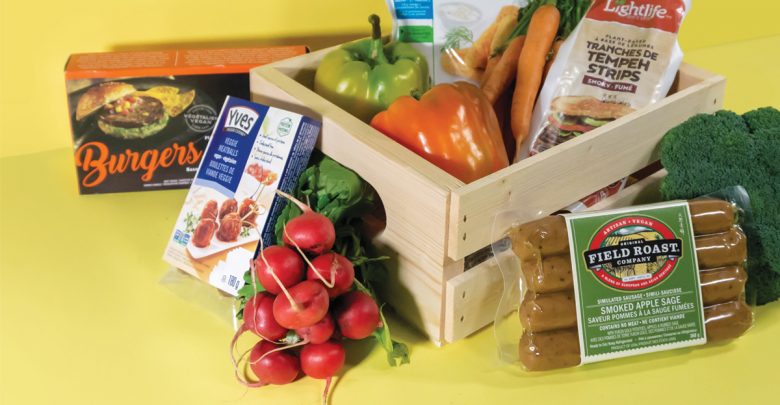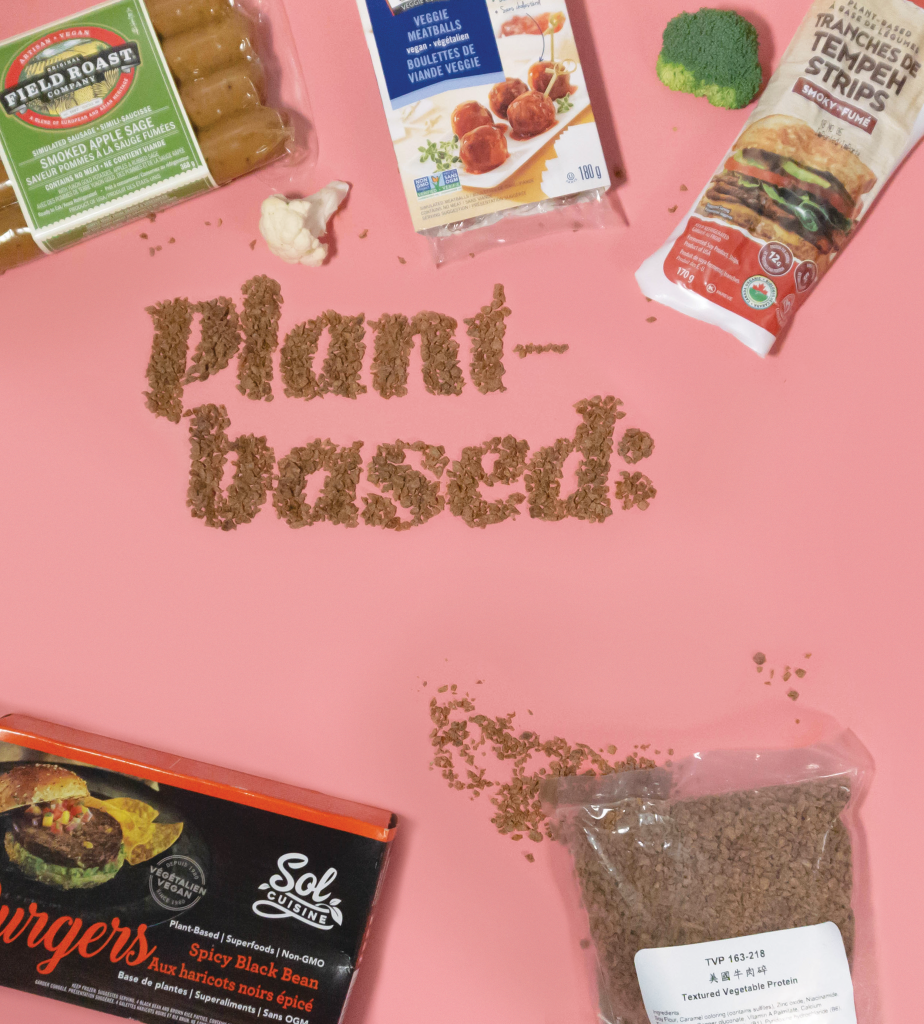 Peter Elima
Peter ElimaImagine for a moment that you’re sitting in Nishi, an upscale restaurant in Manhattan’s Chelsea neighbourhood that is part of esteemed chef David Chang’s elite Momofuku culinary brand. You order the Impossible Burger, one of the restaurant’s famous dishes: a delectable burger expertly glazed in Nishi’s savoury, drool-worthy house sauce, dressed with lettuce, tomatoes, and pickles, and accompanied by fries that are neither too thin nor uncomfortably large. Your teeth sink into the flawlessly prepared meal, and you’re met with the softness of the bun, the meaty texture of the patty, the freshness of the vegetables. The patty bleeds vibrant red, drizzling the plate below. You’ve never had such an amazing burger.
Now imagine walking up to your local A&W here in Edmonton. Maybe even the one in HUB mall on campus. You order the Beyond Meat Burger and have — minus the bustling New York company — close to the same culinary experience. How is this possible?
The meat of the secret lies in the patty. Made by Impossible Foods and Beyond Meat, respectively, both the distant Momofuku Nishi’s Impossible Burger and A&W’s considerably closer to home Beyond Meat Burger contain a patty that is totally plant-based, meaning no animal products whatsoever go into their creation. The Impossible Burger’s famous “blood” can be attributed to the inclusion of plant-originated heme, the component of blood that makes it red, and you can thank pea protein isolates for Beyond Meat’s remarkably animal-like texture. To put it another way, they’re both vegan and vegetarian.
Steadfastly popular in bustling metropolitan centres like Los Angeles and New York City, plant-based lifestyles are drawing local crowds in traditional Albertan beef-repping cities like Edmonton. From A&W’s much-advertised Beyond Meat Burger to the new vegan options available at Hula Poke and Filistix in the University of Alberta’s Students’ Union Building, vegan and vegetarian options are becoming more prevalent. In the last few years, Edmonton has seen an explosion of plant-based restaurants, vendors, and products available in stores — which has had significant implications for Edmontonian eaters and businesses alike.

“Vegetarianism and veganism have been around for hundreds of years, but it hasn’t been until the last five years that we’ve seen the huge growth levels in non-meat alternatives we’ve been experiencing,” says Michael Kalmanovitch, proprietor of Earth’s General Store, a vegan grocery store and mainstay in Edmonton since 1991.
Meat-like substitutes — also called faux meats and vegan meats — are known as “analogues” in the technical food world. Tofurkey, vegan hot dogs, and the Beyond Meat Burger all fall into this category. But like the wide variety of plant-based products on grocery store shelves, analogues vary notably in their ingredients and nutritional content. Some, like chickpea-based burgers, are more natural in their composition; others, such as those made up of ingredients like wheat gluten and isolated soy protein, veer on the more synthetic side of the spectrum.
Natural, plant-based alternatives to animal protein have been around for hundreds of years: think seitan, a wheat-based product; soy products like tofu; and leguminous lentils and beans. Compared to India, China, and other countries and cultures that have long utilized these alternatives, Kalmanovitch says, North America is a neophyte to the plant-based game, albeit one gaining traction with impressive speed as more “mainstream” companies vie for consumers in this largely untapped market.
The involvement of major players in the food industry has had a huge impact on plant-based product development. Imitation meats have made considerable strides since their initial introduction to markets decades ago. David Sun, proprietor of Edmonton’s Orii Vegan & Vegetarian Market and part of its vegan meat manufacturing arm, Happy Veggie World, says the most noticeable difference between the veggie products of old and the modern options on shelves today is the “mouthfeel” of things like veggie patties and vegan sausages.
“There’s been a huge focus on texture,” Sun says. “I think that’s what really freaks people out — not the taste, because [products like] tofu can be covered up with sauces. The old-time [vegetarian] burgers would kind of crumble — they didn’t have that fibrous element to them. Right now, what a lot of manufacturers are doing is working with new types of plants, like mushrooms, that are organically very fibrous.”
The improvement in plant technology has meant that plant-based product lines are no longer exclusive to niche pockets of eaters, a fact made evident by the growing instances of traditional meat-based companies buying up popular vegan and vegetarian brands. In December 2017, Maple Leaf Foods — formerly known as Maple Leaf Meats — acquired the well-known gluten- and plant-based sausage and meat company Field Roast for a tidy $120 million. Kalmanovitch says mainstream brands are willing to fork over these large sums for comparatively smaller brands because of the huge potential the still-developing plant-based market offers businesses.
“There’s steak and there’s burgers and there’s hot dogs, and those have been around for years; there’s nothing new in that,” he adds. “There is growth and potential in vegan markets, and the food industry as a whole wants to be a part of that.”
The trickle-down effect of big business’ interest in plant-based alternatives has manifested at the local level.
“One reason we got into the [vegan meat] business is that I noticed there was a shift,” Sun says. “There was a growing need for vegan and vegetarian meat alternatives, but even just the focus on the environment. People were looking for ways to lower their impact.”
That impact relates to the ethical connotations of veganism, which, as a lifestyle, is closely tied to the environment and animal rights. Typically the label of “vegan” comes with associations of being against certain aspects of animal products, with cruelty to farm animals being one of the most common reasons many people cite for adopting a vegan lifestyle.
“This is the only area in grocery food that is expanding — there’s nothing new in the meat industry,” Kalmanovitch says.
Undercover infiltrations of some modern slaughterhouses have revealed the unethical treatment many farm animals face, with graphic footage of animals being beaten, young male chicks being tossed into grinders alive, pigs being dragged painfully by their ears across the killing floor, and chickens having their sensitive beaks sliced off without anesthesia. Often this treatment goes unseen, and those who choose to be vegan commonly wish to vote with their dollar to avoid supporting these troubling aspects of the meat and dairy industry.
There are also other reasons for not eating meat, like the carbon footprint associated with the mass production of animal products. The Washington Post reported that eating beans instead of a five-ounce steak once a week for a year keeps roughly 331 kilograms of carbon dioxide out of the atmosphere; The Guardian noted that while vegetables take around 322 litres of water per kilogram to produce, animal meats like beef require upwards of 15,415 litres. There are also issues related to water pollution from livestock, deforestation as trees are cleared to create farmland, and wasted crops that feed animals destined for consumption, among other concerns.
“There are a lot of resources that go into producing a steak,” says Julianna Mimande, general manager of local restaurant Noorish Conscious Eatery, located on 109th Street near the U of A. “All the pollution produced by the cattle industry, for example, is terrible for the environment. And a lot of our planet is used to grow food to feed animals that [in turn] feed very few people, when we could be using that food to feed more people [directly].”
Noorish, like many of the restaurants opening now, calls itself “plant-based,” which shies away from the political aspects of veganism and vegetarianism while focusing on the healthiness of plant-based choices for individual consumers and the planet. Noorish itself features items on the menu like king oyster mushroom risotto drizzled in truffle oil and “bacon” cashew cheeseburgers, which make plant-based choices accessible to all kinds of eaters.
Beyond the ethical concerns, there are other reasons to be open to more plants in one’s diet. Research has shown that going vegan may help stave off certain chronic diseases. “[Eating a vegan diet] may prevent heart disease by lowering cholesterol levels; it may help decrease blood pressure or hypertension, and hopefully since you’re eating more fruits and vegetables on a vegan diet, it might increase your levels of antioxidants,” Sabina Valentine, a registered dietician and associate professor at the U of A, says.
While diets lower in animal products may be healthy, the healthiness of faux meats themselves is less established. “A lot of the fake meats out there aren’t necessarily great for you because they do have a lot of additives and they are processed foods,” Valentine explains. “But in the end, what those options offer are fun, treat-type alternatives for those who sometimes miss the texture and flavour of meat.”
Sun agrees. “A lot of people ask, ‘If you’re vegetarian, why even try to simulate meat?’ And that’s a really good question — really, this product [line] is a transition product [from omnivorism to vegetarianism]. A lot of omnivores can’t even tell the difference!”
In other words, these meat alternatives aren’t terrible, but they’re also special indulgences — they’re not meant to be everyday staples.
“Meat alternatives are like cupcakes. When you eat a cupcake, you know it’s not good for you, but it’s delicious and sometimes you just have it,” Valentine says.
On this point, Valentine warns against setting unrealistic expectations about eating foods labelled as vegan or vegetarian. “It can be easy to think, ‘Oh, I’m eating vegetarian; it must be healthier.’ It can be, but it has to be done with a little conviction and effort to get the nutrients you may be deficient in and to avoid products high in sodium, saturated fat, and sugar.”
The real key, Valentine says, is incorporating moderation into plant-based choices. Indulging in processed meat alternatives isn’t harmful every once in a while, but alternatives made of whole foods — unprocessed ingredients that aren’t refined or broken down — are even better than standard faux meats.
“Even a non-vegetarian diet composed of non-processed foods is very healthy; the same goes for vegan and vegetarian diets. Ingesting whole foods, real foods you can get into your diet, will ensure your diet has greater nutrient density,” Valentine says.

Often, though, what makes or breaks the quality of any given plant-based meat alternative is not the actual product itself, but rather the way it is dressed and prepared. By using innovative seasonings and sauces, local restaurants have been able to sway Edmontonians into trying and sticking with once-alien faux meats. Padmanadi Vegetarian Restaurant, a longtime local plant-based joint serving cuisine with Indonesian and Chinese influences, has been successful in its quest to win Edmontonians over with its entirely plant-based menu. Its legendary creamy, spicy coconut milk-based curry “chicken” and crispy “chicken” strips served with homemade hot sauce always have the restaurant busy — something only accomplished, representative Maya Paramitha says, through the innovative creation of great sauces, spice combinations, and seasonings.
“When you see ‘curry chicken’ or ‘ginger beef’ [at Padmanadi], it’s not just the meat — every other component has to be there; the sauces have to be there,” she says. “The full experience of the entire meal as a whole is what makes it so good, not just the faux meat on its own.”
The current success of vegan and vegetarian meat alternatives in the heart of Albertan beef territory raises the question: what do local vendors foresee for the future of plant-based eating in Edmonton?
“We’re definitely seeing that [the popularity of vegan and vegetarian food] is growing,” Sun says. “Our business has grown nearly 2,000 per cent over the last four years — more and more people are seeking [plant-based food] out and looking to find out more information about it.”
This sentiment is echoed by other local vendors. A lot of plant-based food’s staying power relates to its sustainability as a healthy lifestyle rather than a short-term trend.
“Just like any diet — Atkins, [ketogenic diets] — there are trends. But unlike [fad diets], veganism and vegetarianism can be done for the long term,” Paramitha says. “You can be a vegan for 40, 50 years — you can’t do Atkins or keto for 50 years. Veganism is definitely here to stay.”




